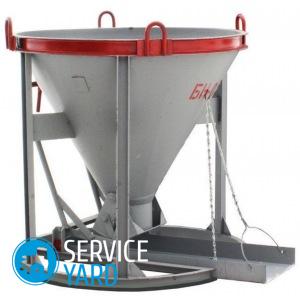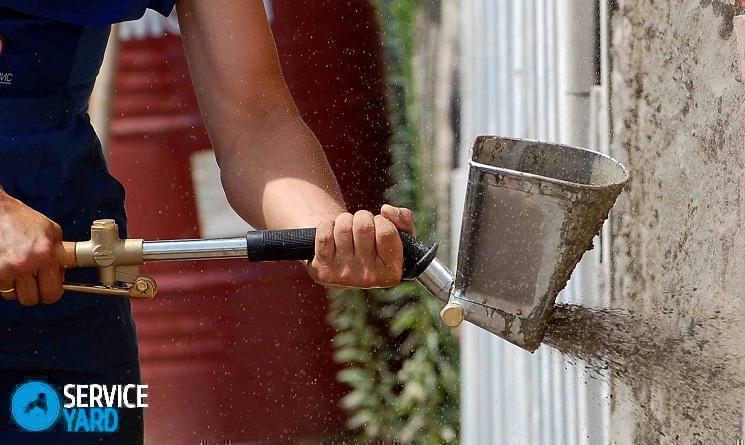DIY hopper bucket

Plastering is the most time-consuming part of the repair. Mechanizing this process is rather difficult, but still there are some devices that can facilitate the work of the finisher. One of them is a special plaster shovel. Do-it-yourself hopper bucket - is it real? This will be discussed in the article.
to contents ↑What is it for?
If you decide to make a hopper bucket with your own hands, the drawings are easiest to find on the Internet, but you can do it yourself. First you need to understand why you need a plaster shovel. Its main purpose is to spread the solution evenly and quickly across the surface. This is especially important if you have to plaster large areas.
to contents ↑Important! You can, of course, buy a hopper bucket at a hardware store. But such a device is quite expensive, so if you are not going to open an apartment repair company, but just want to put your own in order, spending such amounts is hardly advisable.
How does he work?
The name “hopper bucket” comes from the English “to hop” - to bounce. But not the spade itself is jumping, but the mixture with which it is filled. It provides compressed air, which is sent from a plaster gun. An air stream is created thanks to a compressor that attaches to the bucket.
Using such a device allows you to:
- save the solution, since the accuracy of spreading is higher than when finishing manually, by about 30-40%;
- work with a wide variety of solutions, including silk plaster
- receive an even layer of plaster due to the greater impact force than with manual spreading;
- handle complex surfaces;
- use materials of different colors and different textures to process individual sections;
- improve the quality of the coating, because the process goes much faster than manually.
What are the buckets?
Professional finishers have to deal with a variety of surfaces. Therefore, different devices are needed. On sale you can find hopper buckets:
- ceiling;
- wall.
They differ from each other in the design of the holder:
- the ceiling handle is bent at a right angle;
- at the wall, the angle of bending of the handle is at an angle of 45 °.
What materials can I deal with?
Having made a bucket for plaster with your own hands, you will get the opportunity to work with many materials:
- concrete mixes;
- cement-sand mortars;
- cork solutions;
- expanded clay mixtures;
- liquid wallpaper;
- textured paints.
Pros and cons of the device
The hopper bucket allows the finishing material to better grasp the surface. After the introduction of such devices, plastering operations accelerated sharply. It takes no more than 5 seconds to completely empty the tank, so one plasterer using such a device can lay 1-2 cm per hour on a surface of about 60 sq.m.
The main advantages of such an aggregate are not only speed and versatility, but also the fact that an unskilled worker or even an amateur who has undertaken repair work for the first time can cope with a plaster shovel.
to contents ↑Important! The bucket hopper has one drawback - you definitely need a compressor. This is not always convenient, since the unit can not be connected everywhere.In particular, a plaster shovel is difficult to use when working at height.
What does it consist of?
Before you make a hopper bucket with your own hands, it is useful to find out what parts it consists of. A plaster shovel has:
- spray nozzles;
- capacity for solution;
- pneumatic valve;
- fitting with confuser output;
- hose;
- compressor;
- lever.
The spray nozzle (there may be several) directs the working mixture to the surface at a certain speed. The container for the solution can be of different shapes and sizes, so deciding to assemble a hopper bucket, the drawings will have to be customized to fit your own tasks. The shape is also affected by the angle of inclination of the nozzle to the surface.
The industrial hopper bucket is equipped with interchangeable nozzles. This helps to adjust the spray angle depending on the material you have to work with. Typically, the angle is from 30 ° to 90 °.
Important! If the slope is less than the minimum, productivity decreases, and if it is more, the spraying speed decreases.
A pneumatic valve is needed so that the working mixture enters the nozzle. The fitting gives the outgoing solution the necessary speed. Finally, the shape of the handle depends on what kind of surface you are going to plaster.
to contents ↑Important! Industrial hopper buckets are equipped with compressors, and if you decide to make such an assembly yourself, you will have to select a compressor.
Making a hopper bucket
To make a do-it-yourself hopper bucket out of the tools at hand, select the drawing, dimensions and shape depending on what exactly you will be plastering and with which solution.
To make you need
- thin sheet stainless steel;
- Bulgarian;
- welding tool:
- ruler;
- pencil;
- graph paper.
Make capacity
You will find many functional devices of this type. Industrial units usually have a shape similar to a regular bucket, but with a narrower lower part. This is not always convenient. A rectangular section is preferred. First you need to make a drawing:
- Take a large sheet of graph paper.
- Draw a vertical line 60 cm long.
- From the same point, draw a horizontal line 20 cm long.
- Draw a rectangle 60x20 cm.
- Divide the vertical line into 3 equal parts to get 20 cm segments, mark the resulting points as A and B.
- From points A and B, draw horizontal lines parallel to the sides of the rectangle.
- On these lines, set aside 5 cm from each horizontal angle, denoting A1 and A2, B1 and B2.
- Connect them in pairs with vertical segments - A1 and B1, A2 and B2, the resulting rectangle will be the central part of the bucket.
- Connect the points A1 and A2 with the upper corners of the large rectangle, and B1 and B2 with the lower ones, you should get a figure that looks like an hourglass.
Side parts
They are two identical trapezoid.
- On a graph paper sheet, draw a horizontal line 20 cm long.
- Add 1.5 cm on each side.
- Divide the line in half.
- Draw a vertical line 20 cm long and mark a point, for example N.
- From point H, set aside 5 cm horizontally on one side and the other.
- Connect these two new points with straight lines with the ends of the first segment.
- Cut both patterns, transfer them to a steel sheet, and there should be two sidewalls.
- Cut parts (best grinder).
- Weld the parts.
- Decide what diameter the nozzles should have — usually 2 mm or 3 mm.
- Make holes for them.
- Insert valve.
- Attach the holder.
- Connect the compressor.
The capacity can be made not only of sheet steel, but also of aluminum. It is lighter, although it lends itself to deformation. Seams can be fixed with two strips of duralumin. The aluminum bucket is made on self-tapping screws, but you need to make sure that the parts fit snugly against each other, without any gaps - otherwise the solution will leak.
Important! The device should be lightweight (up to 5 kg), otherwise - you will not be able to work with it for a long time.
Compressor
It is not necessary to buy it at all.It is possible that you have a suitable device in your household that can give 60-70 atmospheres at a flow rate of at least 500 liters per minute. A unit with a receiver volume of 50 l or more is suitable.
Important! A vacuum cleaner for such purposes is not suitable, because it does not provide stable pressure.
Where to get the valve?
Some parts for the plaster shovel, of course, will have to be purchased. However, as a pneumatic valve, one that is used for inflation of tires, or a ball valve, is quite suitable.
Important! The second option is worse - to instantly stop the flow of the mixture does not work.
Assembling the design
The do-it-yourself handle for the bucket should be comfortable. Think about which hand should account for the main weight load. The right-handed holder will be on the left, the left-hander - on the contrary. You still need fastenings to hold the spray gun and the nozzle hole:
- Put the bucket on the spray bottle.
- Attach a hose to the spray gun.
- Attach the other end of the hose to the compressor.
Plastering the wall
The time has come to try out the device:
- Connect the compressor to the bucket - there is a rubber hose for this.
- Put the working mixture into the bucket.
- Open the pneumatic valve - there is a special lever for this.
- Compressed air will go into the container with the solution, using nozzles to capture the particles of the mixture.
- The outward flow of the solution along with the air will exit through the nozzle.
- When moving the bucket, adjust the layer overlay.
A bit about technology
Even if you assembled everything correctly, some frustrations may await you while you work. To avoid them, study the technology of plastering:
- Before you start plastering, set up beacons - gypsum, concrete or alabaster bulges. They are needed to maintain the thickness of the layer and provide better adhesion of the mixture and the surface.
- Wet the wall with water.
- Dampen the bucket with water.
- Make a supply of the solution, taking into account that it is consumed very quickly - in 3-4 minutes you can spray at least 50 kg of the mixture.
- Spray the mixture immediately after cooking - keep the hopper bucket at a distance of 4-5 cm from the wall or ceiling.
- Align the layer using the construction rule.
- Sand the wall with sandpaper.
Bucket Hopper Care
During operation, make sure that the solution does not stick to the outside of the bucket. As for leaving, it will be exactly the same as for the unit of factory production:
- When finished, wipe off any remaining solution with a rag.
- Turn on the compressor and blow out the nozzles.
- Lower the hopper bucket into a bucket of water.
- Wipe off the container.
to contents ↑Important! If during the plastering work you are forced to interrupt, dip the bucket in water and wash, and then leave it in water until the start of a new phase of work.
Stock footage
From this article you learned everything about such an interesting device as a hopper bucket. We hope you managed to make an effective tool with your own hands, and you do not regret that you spent time assembling it.
- How to choose a vacuum cleaner taking into account the characteristics of the house and coatings?
- What to look for when choosing a water delivery
- How to quickly create comfort at home - tips for housewives
- How to choose the perfect TV - useful tips
- What to look for when choosing blinds
- What should be running shoes?
- What useful things can you buy in a hardware store
- Iphone 11 pro max review
- Than iPhone is better than Android smartphones




